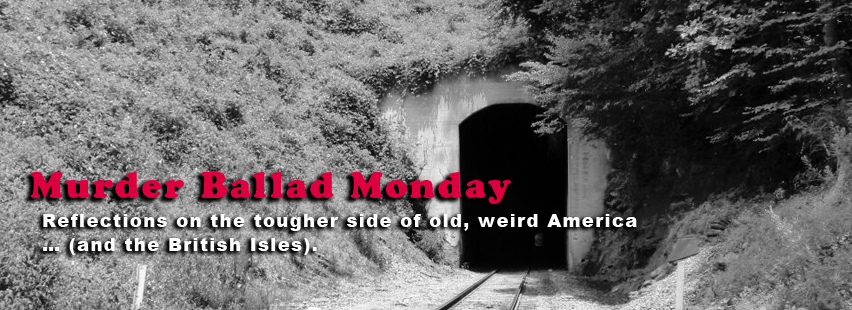The Farmer’s Curst Wife / Little Devils
<<<Back to page 2
Coda – “She lifted her hatchet and murdered them all!”
Wait, this is a murder ballad blog! Why are we laughing?
Seriously, does violence in a comic song do more than grab attention? Does it serve any of the traditional functions of such imagery in murder ballads? Not so much, or so I suspect. One could argue that the ‘battle axe’ stereotype is a warning of sorts, but it’s impossible to imagine that the purpose of this song when sung by men down through the ages was to warn other men off of marriage. Of course, when sung by self-respecting women or sympathetic men we can see that the violence represented strength in womanhood. But it hardly seems like the hyper-macho ‘bad man’ we see in a song like “Little Sadie”, nor do we see anything of the complex intersection of gender, class, honor, love, and law we find in a ballad like “Matty Groves.”
But does the graphic violence in so many versions of the ballad play some role in the creation of Atkinson’s “ambivalent engagement” with women’s power? All I can say for sure is that it did for me.
My first exposure to this ballad didn’t come from Jean Ritchie. It was rather from Seamus Ennis on a cassette tape I picked up when I was in college and first venturing into the world of folk music. I thought it quite odd because, though I’d recently been introduced to murder ballads, I’d never heard a song that was clearly meant to be funny also use such violent imagery. I heard it all then, as I still do, as a nod to women’s strength.
“She lifted a hatchet and murdered them all.” Yeah, that’s not what I’d known up to that point as comedy! But by the time I heard other versions, like Ritchie’s, where brains are bashed out and the like, I was acculturated. Steady listening to traditional music will do that to you. Maybe my preparation started earlier though.
As the son and grandson of proud Appalachian women, I rather suspect the grit and violence was just part of the whole package with songs like this. Women that grew up in rural mountain communities had to be strong, and they routinely got more than dirt on their hands. I remember well my grandmother with her hatchet, decapitating chickens for a family meal. She may have even cussed them as ‘little devils’ when they scratched at her – I know she called me and my brother that more than once! Anyway, when she was a girl in the hills she had to do bloodier things, as did my mother. Violent images in comic songs might be jolting to us today, but I imagine that to traditional rural people they fit right in with the good fun of the music.
That’s not to say that the image of an old woman braining demons doesn’t help create Atkinson’s “ambivalence” – it clearly does. I just think we should be careful, as murder ballad aficionados, not to read too much into it. Comic ballads may use some of the same devices as murder ballads – even powerfully so – but those devices don’t usually serve the same purposes.
Consider – even those of us who study murder ballads are still shocked by the violence within them. On the other hand, who doesn’t want to see a bunch of little devils catch Hell from an old lady? I sure do.
Thanks for reading this week, folks!


